Stay in touch
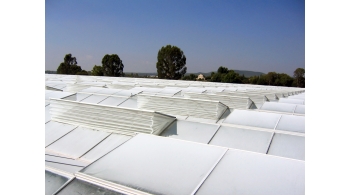
Guide for selecting the best insect netting for your greenhouse
Greenhouse netting has emerged as a vital technology in agriculture, offering both crop protection and a step towards sustainable farming. It serves as a barrier against pests, reducing the need for chemical pesticides and fostering a healthier environment. With its ability to last up to 15 years, netting is a cost-effective and eco-friendly investment for growers. Here are 8 practical tips for selecting the most suitable insect netting for your greenhouse:
1. Identify Your Cultivation Needs: Understand the specific requirements of your crops to match with the right netting solution. A knowledgeable supplier can guide you and arrange visits to see successful implementations.
2. Target Specific Pests: Knowing the pests you need to guard against helps in choosing the netting with the appropriate mesh size for effective protection.
3. Assess Ventilation Requirements: Select a netting solution that accommodates your greenhouse's ventilation needs without compromising climate control. Tools are available to calculate the impact of netting on ventilation.
4. Consider Light Penetration: Different netting systems impact light entry variably. Opt for a solution that aligns with the acceptable level of light reduction for your crops.
5. Evaluate the Investment: Determine a feasible payback period. Consider the netting's lifespan and UV stability in your cost-benefit analysis.
6. Installation Feasibility: Installation methods vary, especially in existing greenhouses. Choose a netting system that can be installed safely and conveniently, with minimal disruption to your crops.
7. Maintenance Demands: Understand the maintenance requirements of your chosen netting system. Opt for dirt-repellent options if possible to reduce upkeep.
8. Financing Options: Explore financing solutions that suit your budget, including the possibility of matching operational cost savings with a fixed monthly payment for the netting system.
By carefully evaluating these factors, you can ensure your investment in greenhouse netting meets your agricultural needs, supports biodiversity, and contributes to more sustainable food production.
Source: Holland Gaas
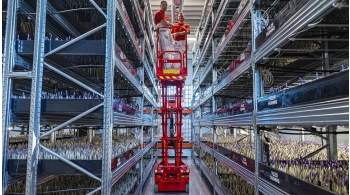
Saffron: The Emerging Treasure of Greenhouse Farming
Saffron, a precious spice with a rich history and unparalleled flavor, represents a unique and promising opportunity for the development of greenhouse farming. Extracted from the flowers of the Crocus Sativus, saffron is not only a culinary delight but also a symbol of luxury that has withstood the ages. Its journey from ancient botanical texts to modern kitchens and scientific laboratories underscores its evergreen appeal and increasing significance.
Saffron: The Path to Success in Greenhouse Business
The history of saffron begins in ancient times, and today it remains one of the most valuable spices. Iran leads in global production, but the high cost of the spice, reaching about $5 per gram in the USA, makes it a profitable choice for greenhouse farmers around the world. Modern research confirms the potential of saffron in the health and wellness sector, further increasing its demand.
Innovations in Greenhouse Cultivation
Greenhouse cultivation, employing advanced technologies such as hydroponics and LED lighting, creates ideal conditions for the cultivation of saffron. This method not only ensures high quality and stability of the harvest but also allows for several harvests a year, increasing profitability.
Economic and Environmental Benefits
The reduction in land use and the possibility of frequent harvesting make greenhouse cultivation of saffron a profitable and sustainable direction. This is a great opportunity for farmers to carve out their niche in the market with a product that enjoys constant demand and growing popularity.
The Future of Saffron in Greenhouses
The future looks bright for those engaged in the cultivation of saffron in greenhouses. This method allows overcoming key difficulties, such as climate sensitivity and labor-intensive processes, making the cultivation of saffron more accessible and sustainable. As the industry grows, new horizons for innovation and profitability open up, making the cultivation of saffron in greenhouses an attractive and profitable direction.
Have questions? Contact us, we will help!
Sourse iGrow News
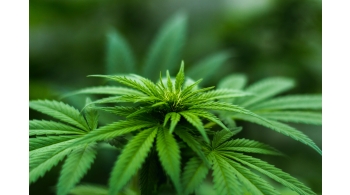
The cultivation of medical cannabis has been legalized in Ukraine
On December 21, 2023, the Ukrainian Verkhovna Rada enacted a landmark legislation that legalizes the use of medicinal cannabis. This pivotal decision not only heralds a new era in Ukraine's healthcare but also represents a substantial advancement for the greenhouse industry, especially in light of the stringent cultivation and oversight requirements involved.
The legislation strictly regulates that cannabis usage is confined to medical, scientific, and industrial applications, with recreational consumption remaining unlawful. Importantly, the cultivation of cannabis is restricted to legal entities holding the requisite licenses and certificates, and each cannabis plant will undergo individual tagging to facilitate tracking.
This move opens up novel opportunities and poses challenges for greenhouse producers. There is an escalating demand for technologically advanced greenhouses, equipped for continuous surveillance and adhering to GMP (Good Manufacturing Practice) standards, presenting a substantial market for firms specializing in constructing and servicing such advanced greenhouses.
Following the law's enactment, an increased demand is anticipated for state-of-the-art greenhouses and related equipment necessary for the quality control and cultivation of medical cannabis. This not only fortifies the healthcare sector but also paves the way for vast opportunities in the industrial cultivation of cannabis, which is poised to significantly benefit greenhouse suppliers and associated technological sectors. Given the global trends and the emergence of this new market, there are strong indicators pointing towards a boom in the cultivation of medical cannabis in Ukraine.
The law is set to take effect in 6 months, providing a crucial window for preparation and adaptation to the new standards. This period is vital for all involved parties to gear up for impending shifts and seize the emerging opportunities in this progressive domain.
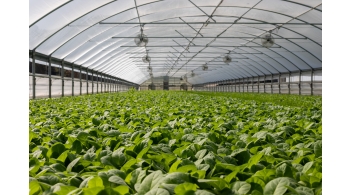
10 tips for success in the greenhouse business
Today, greenhouse cultivation is at the forefront of attention, especially in light of the grant support program for greenhouse construction. The pronounced interest in this field speaks of its importance and potential for the development of the agro-industrial sector at a commercial level. Given these current trends, we offer to consider the key aspects and tips that will help greenhouse growers achieve success in their efforts. 10 tips for successful greenhouse cultivation:
Choose the right growing substrate:
Selecting the appropriate substrate is key for successful cultivation. Factors such as water retention, aeration, and nutrient availability need to be considered. Research and consult with experts to determine the ideal substrate for your specific crops.
Optimize your watering system:
Effective watering is crucial for healthy plant growth and water conservation. Implement precise watering methods, such as drip or micro-irrigation, to ensure accurate watering while minimizing losses. Regularly monitor moisture levels to avoid over-watering or under-watering.
Pay attention to crop protection:
Protecting your crops from pests, diseases, and environmental stresses is vital for maintaining productivity. Develop integrated pest management strategies focusing on prevention, biological control methods, and targeted chemical treatments. Regular monitoring will help identify potential threats at early stages.
Implement environmental control:
Maintaining optimal conditions in your cultivation complex enhances crop growth and yield. Invest in advanced technologies for temperature, humidity, and ventilation control. Automated systems can efficiently regulate these factors, providing a stable and conducive environment for your plants.
Choose the path of sustainable development:
Sustainability is becoming an increasingly relevant issue in the greenhouse industry. Opt for environmentally friendly methods such as water recycling, energy-efficient lighting, and organic fertilizers. Minimize waste production and explore renewable energy options to reduce your ecological footprint.
Rely on accurate data when making decisions:
Use technology and data analytics for informed decision-making. Track and record key parameters like temperature, humidity, and light intensity. Analyze the gathered data to identify patterns and optimize crop management strategies, enhancing efficiency and yield.
Invest in Quality Equipment:
Utilizing reliable and efficient equipment is key to maximizing productivity. Invest in high-quality machinery such as greenhouse structures, lighting systems, and climate control devices. Quality equipment ensures better plant productivity, reduces downtimes, and enhances overall profitability.
Maintain the Professionalism of Your Team:
Cultivate a skilled workforce that understands the intricacies of horticulture and can adapt to new technologies. Provide opportunities for training and education to enhance their knowledge. Encourage your team towards innovation and process optimization, leading to increased productivity and quality.
Enhance Plant Nutrition:
Provide your plants with a balanced and tailored nutrition program. Regularly conduct soil and tissue analysis to determine nutrient deficiencies or excesses. Adjust fertilizer programs accordingly to optimize plant health and maximize yield.
Stay Informed and Network:
Keep abreast of the latest trends, research, and innovations in the horticultural industry. Attend exhibitions, conferences, and webinars to expand your knowledge and connect with industry experts. Building relationships and timely information consumption will help you always stay a step ahead and adapt to new advancements.
Have questions? Our team is here to help!
Source: hortidaily.com
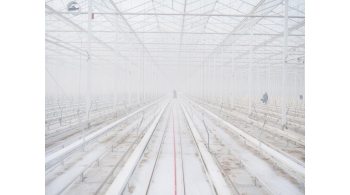
The Five-Step Guide to Achieving 100% Greenhouse Cleanliness and Disinfection
Ensuring the cleanliness and disinfection of your greenhouse is of utmost importance. Achieving 100% cleanliness is crucial because anything less, like 99%, can leave dormant pathogens that might resurface and infect your next crop.
1. Effective Cleaning Before Disinfection
Remember, disinfection without thorough cleaning makes no sense. Disinfectants typically work on the surfaces they touch and may not penetrate deeper layers. This means that while the surface may appear disinfected, pathogens may still lurk beneath the pollution. For gutter cleaning, avoid using just water; remove contaminants.
2. Select the Right Disinfectant
Identify the specific pathogen you're dealing with and choose a product with the appropriate properties. If your goal is to eliminate viruses, ensure you select a product designed for that purpose with the right dosage and contact time. Opt for a versatile disinfectant effective against various pathogens.
3. Search for Hidden Pathogens
Keep in mind that bacteria, fungi, and viruses are tiny. They can hide in seemingly flat surfaces. Even a coated gutter may have hidden spots when viewed under a microscope. Using a product with a good wetting agent is essential to reach these hidden areas.
4. Examine Your Water System
Your water system serves as a highway for infections. Empty greenhouse periods are ideal for inspecting your water system. Check for any biofilm buildup in storage tanks, as clean water addition doesn't guarantee cleanliness. Clean your system without leaving residues, ensuring a clean system throughout the season.
5. Maintain Cleanliness
Once your greenhouse is clean, the real challenge is maintaining that cleanliness. Establish a robust hygiene protocol for the production phase and ensure that your staff is well-informed and actively engaged in maintaining hygiene standards.
The success of your greenhouse depends on a clean and pathogen-free environment. Keep it clean!
Sourse Hortidaily.com
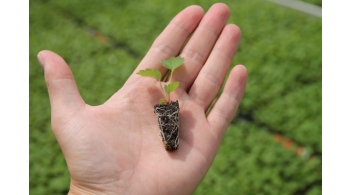
Revolutionizing Strawberry Farming: Introducing Japanese Innovative F1 Seed Varieties for Global Markets
The Miyoshi Group, a renowned Japanese agricultural organization, has introduced two groundbreaking F1 strawberry varieties, marking a significant stride towards exporting Japanese strawberry seeds to global markets. The recently released varieties possess the unique advantage of an accelerated growth cycle, allowing for ripe strawberries as early as June. This innovation stems from the ability to grow the strawberry plants directly from Miyoshi F1 seeds, eliminating the need for mother plant propagation. This streamlined approach not only slashes greenhouse cultivation time but also reduces the overall production process by up to three months. Such a methodology also curtails labor expenses, environmental impact, and production space requirements, aligning well with the growing demand for sustainable agricultural practices.
Noteworthy is the environmental impact reduction, encompassing decreased chemical application, lower heating costs, and minimized fertilizer use, equating to over 40% fewer CO2 emissions and an almost 80% reduction in chemical inputs when contrasted with traditional mother plant-based production methods. The Berry Pop F1 Seed Strawberry Project, characterized by vibrant imagery and a clear Japanese identity, has launched with two inaugural varieties: Berry Pop Sakura and Berry Pop Haruhi, both boasting unique flavor profiles.
Sourse: hortidaily.com
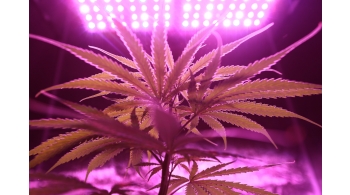
Legalization of medical cannabis in Ukraine: first steps are done
The legalization of medical cannabis in Ukraine has become a long-awaited event for the country's healthcare system. The bill on the legalization of medical cannabis was supported by the Cabinet of Ministers after years of efforts from activists, scientists, and medical professionals. This issue has been surrounded by numerous political manipulations and insufficient awareness. Therefore, it is important to understand why medical hemp is significant and why its legalization is a right step in the development of the medical and scientific spheres.
One of the key aspects of the bill pertains to controlling the content of tetrahydrocannabinol (THC) in cannabis for medical purposes. The project stipulates that permitted preparations with THC content will not exceed 0.2%, as it is in the EU, which will help reduce the risk of addiction. It is crucial to distinguish medical cannabis from illegal drugs and recognize its potential in treating various conditions.
Even with limited evidence on the effectiveness and side effects of medical cannabis, it is necessary to comprehend that research is essential for developing medical drugs based on it. The prohibition of studying the plant by Ukrainian scientists puts our country in an unfavorable position, and legalization opens opportunities for scientific research and the development of new therapeutic methods.
A particular focus should be placed on the possibilities of treating post-traumatic stress disorder (PTSD) with medical cannabis. Some studies indicate that this plant-based preparation can help veterans cope with PTSD symptoms. Ensuring legal access to medical cannabis can be a significant step in providing veterans with proper treatment and support.
Of course, some people are concerned about the potential abuse of legalized cannabis. However, it is essential to understand that controlled and limited access to medications is crucial in reducing negative consequences. The application of medical cannabis should be based on scientific evidence and adhere to strict safety standards.
Before legalizing medical cannabis, careful consideration should be given to its accessibility and regulation. History shows that previous attempts at legalization were not always successful due to improper implementation or insufficient control over the supply.
Nevertheless, the goal of legalizing medical cannabis represents a significant boost in opportunities for medicine and science in Ukraine. Ensuring access to research and medical preparations based on cannabis stimulates the development of medical science and can aid patients with various conditions, including PTSD.
Therefore, we closely follow Ukraine's path towards new therapeutic and business opportunities!
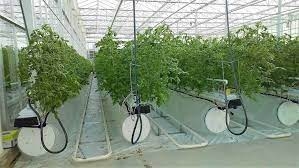
Is it practical to build semi-closed greenhouses?
In the world of agriculture, new technologies and innovations aimed at increasing efficiency and improving growing conditions for plants emerge every year. One such innovation is the fifth generation greenhouses. They are modern structures designed to provide optimal conditions for plants inside. But is it worth investing in them in certain climatic conditions?
The main feature of fifth generation greenhouses, or as they are correctly called, semi-closed greenhouses, is the use of cooling systems with wet pads. These systems ensure an efficient cooling process inside the greenhouse, which is particularly beneficial in climates with low humidity. In such conditions, where the humidity is less than 60%, fifth generation greenhouses can be highly effective and bring significant benefits.
However, in countries with climates where humidity exceeds 60%, the efficiency of cooling systems using wet pads decreases. This is because at higher air humidity, wet materials are not able to effectively cool the air inside the greenhouse. In such cases, investing in fifth generation greenhouses may simply result in overpayment, as the cooling systems cannot operate at maximum efficiency.
Therefore, the construction of fifth generation greenhouses in countries like Ukraine, Kazakhstan, and other countries with similar climatic conditions may raise doubts. Before deciding to build such greenhouses in these regions, it is necessary to carefully analyze climatic data, including air humidity, and assess how effectively the cooling systems with wet pads will function.
However, it is worth noting that fifth generation greenhouses have important advantages and high efficiency in suitable climatic conditions. They provide more stable and optimal conditions for plant growth and development, which can lead to increased yields and improved product quality. This is achieved by maintaining carbon dioxide levels inside the greenhouse without the need for ventilation windows, as is commonly used in traditional greenhouses for cooling purposes.
In conclusion, the feasibility of constructing fifth generation greenhouses depends on the climatic conditions of a specific region. In countries with low air humidity, these greenhouses can be highly effective. However, in more humid climates like most post-Soviet countries, their efficiency may be limited.
Feel free to contact us for more information, and our team will provide guidance on what is best for you!

A Novel Greenhouse Vegetable for the European Market
Zucchiolo, a crossbreed between zucchini and cucumber. The plant combines characteristics of both vegetables and is suitable for greenhouse cultivation. With high yields of 9-11 kg/m² and adaptable planting densities, Zucchiolo offers a potential yield exceeding 100,000 kg per hectare. Its tricolor varieties include dark green, light green, and yellow options. Zucchiolo can be consumed fresh or cooked, with a soft texture and no thorns, and has a post-harvest shelf life of up to three weeks outside the refrigerator. Its versatility and unique features make it a remarkable addition to the European market.
Sourse: Hortidaily
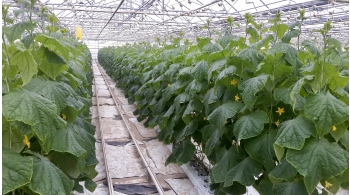
Development of Greenhouse Farming in Ukraine: Benefits and Challenges
The Ministry of Agrarian Policy and Food of Ukraine has started developing grant programs for the creation or development of greenhouse farming or horticulture, which is an important step in supporting the industry that previously received insufficient support from the state. However, according to the Ministry, only 11 grants have been issued so far for greenhouse construction, and many entrepreneurs do not participate in this program due to uncertainty with electricity supply.
UKAB analyst Maxim Gopka notes that the greenhouse market in Ukraine is undersaturated, and greenhouse vegetables are becoming increasingly popular among the population. Greenhouse owners also have advantages due to higher yields and the ability to grow organic vegetables year-round.
However, Anatolii Kinakh, President of the Ukrainian League of Industrialists and Entrepreneurs, notes that the state focuses on supporting large farms, not paying enough attention to small and medium-sized producers. He also believes that free educational webinars for entrepreneurship and business organizations are needed to expand grant opportunities and attract more participants to the industry.
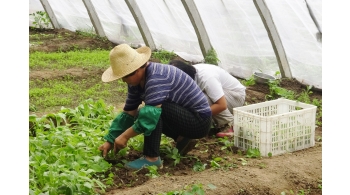
Due to the war in Ukraine, around 35% of greenhouse farms have stopped operating
Last year, prices for greenhouse tomatoes and cucumbers were at record highs. However, not many greenhouse complexes took advantage of these prices with the onset of cold weather, as even the high cost of vegetables did not cover the production costs that had risen due to the energy crisis.
At the end of 2022, the issue of high prices for energy carriers was compounded by problems caused by attacks on the energy infrastructure by the Russian occupying army. As a result, many greenhouse complexes in Ukraine decided not to continue production during the winter season.
"Last year, the price of gas was indeed high, and this increased expenses. Of course, war brings difficulties, as it creates an imbalance in demand for products on the market. Also, until February, we had problems with electricity supply, which is important for the greenhouse business. For greenhouse farms, costs for logistics, fuel, and packaging have increased. There is an example where large greenhouse complexes switched to growing tomatoes instead of cucumbers because cucumbers require more energy costs, even though they grow faster," says Maxim Hopka, an analyst at the Ukrainian Club of Agricultural Business (UCAB).
"Indeed, the market has shrunk because there are fewer consumers - people have left the country. In addition, consumers' incomes have decreased. Accordingly, production has also decreased because the market does not need so much produce," says economist Andriy Yarmak from the Investment Department of the UN Food and Agriculture Organization (FAO).
According to Yarmak, high energy costs have forced greenhouse growers to optimize their season by focusing on minimal greenhouse heating, which also leads to a reduction in production. But this trend is also happening in parallel with a decrease in demand
According to the Ukrainian Union of Industrialists and Entrepreneurs (USPP), about 35% of greenhouse farms have stopped operating due to the war. Many of them experienced economic difficulties in 2021, when there was a crisis in gas price hikes.
Heating greenhouse farms with gas is expensive. Therefore, many producers in Ukraine are switching to alternative fuels, such as biomass, building bio-power plants, and so on. The cost of electricity has also increased by about 40%, which is one of the main cost components for greenhouse growers - growing seedlings requires maximum lighting. Kinakh emphasized that greenhouse farming is one of the most energy-intensive areas in agriculture.
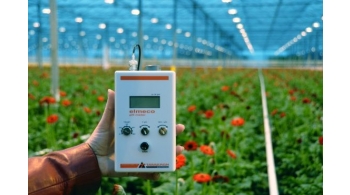
Boosting Plant Growth: The Role of CO2 Dosage in Greenhouse Horticulture
Carbon dioxide (CO2) is a colorless, odorless gas that plays a vital role in plant growth. In greenhouse horticulture, CO2 is used to enhance the photosynthesis process, which is essential for plant growth and yield. Photosynthesis is the process by which plants use sunlight, water, and CO2 to produce energy-rich molecules such as sugars and starches, which they use as food.
CO2 is one of the raw materials required for photosynthesis. However, in a typical greenhouse, the amount of CO2 is often less than what plants need to perform optimally. Therefore, greenhouse growers use CO2 dosing to supplement the natural levels of CO2 in the air. CO2 dosing involves adding extra CO2 to the greenhouse environment to increase the concentration of CO2 in the air. This is typically achieved by using CO2 generators or burners, which produce CO2 by burning natural gas or propane.
The benefits of CO2 dosing in greenhouses are numerous. First, CO2 dosing can increase the rate of photosynthesis, leading to faster plant growth and higher yields. Secondly, CO2 dosing can help plants to use water more efficiently, reducing the need for irrigation. Thirdly, CO2 dosing can help plants to tolerate higher temperatures, allowing growers to maintain optimal growing conditions even during periods of hot weather.
However, it is important to note that CO2 dosing should be done in moderation. Too much CO2 can be harmful to plants, and excessive levels of CO2 can lead to reduced growth, stunted development. Therefore, it is essential to monitor CO2 levels regularly and adjust dosing accordingly. By supplementing natural levels of CO2, greenhouse growers can create an optimal growing environment that promotes healthy plant growth and development. However, it is crucial to monitor CO2 levels regularly and adjust dosing accordingly to avoid harmful effects on plant growth.

Don’t give up, just do it: Building rooftop greenhouse in Ukraine during the wartime
A fully equipped rooftop greenhouse was recently commissioned by Perspekta Group team in Kyiv area, Ukraine. It took almost two month of building, in cold winter weather while overhearing missile attacks, for the project to be done.
The greenhouse is equipped with such systems as LED lighting, high pressure misting system, energy-saving screening system, irrigation and heating which allow control the climate and grow crop all year-round. Combination of hydroponic vertical towers and raised beds with different growing substrate allow flexibility in types of crop and methods to grow.
Goals and benefits of rooftop greenhouse reached:
- Space efficiency: A rooftop greenhouse maximizes the use of available space.
- Year-round growing: Rooftop greenhouses provide an ideal environment for growing plants. This allows for a constant supply of fresh produce.
- Increased food security: With a rooftop greenhouse, building owners can grow their own fresh produce, reducing their reliance on imported produce. This is particularly important in Ukraine with limited access to fresh and healthy food options.
We already are working on the next project to be built on the rooftop, also fully equipped for year-round growing. Fingers crossed; the peaceful time will come soon. We do believe a rooftop greenhouse will be the trend all over the country when peace is there.
Perspekta Group is the leading greenhouse builder in Ukraine. The company has earned recognition for undertaking large, complex projects, fostering innovation, embracing traditional and emerging technologies, and making a difference for their clients. Simultaneously, the residential division of Perspekta has provided functional beautification to many of the nation’s most desirable estates.
By focusing on Design-Build project delivery, Perspekta team brings best the world has to offer in growing technologies to Ukraine, in order to create a lasting positive legacy.
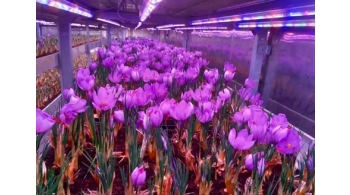
Growing saffron goes vertical
A new growing system initiated in Italy shows that growing saffron can be easy and profitable by growing vertically in the containers. Now saffron, one of the most expensive and rare spice, can be grown in hydroponic vertical system, a container farm.
"To get to the amount of 2 kg in dried pistils on a yearly basis in the open field, you'd at least need about 1,000m2. However, our container equals that number with its multiple layers. Besides that, the product quality is outstanding, as we don't have the same risks as open-field growers do." - Daniele Bertocchi, owner of Italian container company says.
The chemical analysis has shown that the parameters of bittering, coloring and flavoring properties are far within the first category of conventionally grown saffron. To illustrate the outcome; the coloring power, expressed as 'crocin,' stood at 280 ± 34; the bittering power, expressed as picrocrocin, stood at 111 ± 16; and the flavoring power, expressed as 'safranal,' stood at 29.9 ± 4.0.
Meaning that these results all fall into the minimum requirements for the first category of saffron production. With that said, you can install in you back yard a container and make money by supplying rare expensive spice to the restaurants around, for instance!
Sourced at hortidaily.com

Practical recommendations for choosing a site for greenhouses
We talk about the important nuances that you can take into account when choosing a site for maximum greenhouse efficiency. Briefly they are: solar activity, shading, zoning, wind and access to water and electricity. More details below.
Location
First, let's start from the place where it is allowed to build a greenhouse according to state norms. It is important to take into account the distance from power lines, gas pipes, etc. Tree uprooting is often not allowed or too expensive thus it's best to look for treeless areas.
Lack of access to water can be a problem. The quality of the water is not as important becasue it can be treated with purification processes.
Electricity must be available. Determining the required voltage is also key in the planning. Most greenhouses require 480V 3-phase, which is not available in all areas or can be expensive to connect.
Internet access and a satellite connection are also important because most systems use the Internet to signal danger or system’s failure.
A distance of the greenhouse for workers is important factor as well. If they have to spend more than 1 hour to get to work, it will be difficult for you to keep workers. This is a serious problem if you want to grow crop successfully and have an efficient staff.
Also take into account the distance to the market or other sale points of your products. You will save time and fuel if you are closer to your distributors or customers. It is often the deciding factor for product sales and business development.
Climate conditions
Shading/percentage of sunshine at any time of the year is an important factor in plant growth that you can use for your profit or additional cost.
Solar activity and shading varies from place to place, especially in mountainous and wooded areas. Solar activity is essential for sufficient growth and passive solar heating.
If the site is shaded during the winter, this can result in lost production or increased lighting costs. In summer, some shading is usually not a significant disadvantage and even benefits the greenhouse by reducing heat gain and preventing overheating. Many growers use shading and cooling strategies to help keep their greenhouse cool in the summer, and it's cheaper than the extra cost of lighting and heating.
Maps and weather websites such as NREL or NASA can give you an idea of the overall light levels in your area. From there you can get more detailed information about a particular site by evaluating anything that might obscure the greenhouse (called obstructions), such as buildings or neighboring trees.
If there are obstacles nearby, we recommend considering their effect on the greenhouse. This can be done in several ways, such as using trigonometry and sketching surrounding objects. A tool called the Solar Pathfinder is another option, like getting a greenhouse designer or engineer to model your site and provide shadows.
Lux meters are another option, but it's usually difficult to give a complete picture of light levels throughout the year. The luxmeter measures the level of illumination in real time. To get a complete picture of the light in your location, a data logger or multiple measurements over a period of time is needed.
Wind is also an important factor. The higher the wind loads, the more expensive the greenhouse will be, because the structure must be stronger than in other regions.
Potentially wind also leads to more wear on the glazing or plastic film and increases wear on the structure. Air vents are especially sensitive to the "sail effect" - they are often torn off during strong gusts. Therefore, the ideal place for a greenhouse is protected from strong winds.
Check if the property is in a flood zone. Placing in the lowlands can cost the harvest.
If there is a hail problem in your area, engineers should take this into account when calculating roof loads and equipment specifications. The frequency and size of hail will greatly influence the choice of greenhouse cover.
Take note and forward to new achievements! If you have sites where you like to build a greenhouse but still doubt, please contact us. Perspekta team will be happy to help and suggest the best option available.
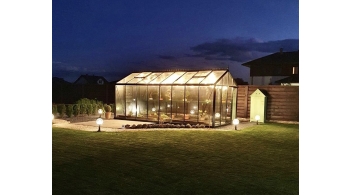
2023 New Year special deal for hobby greenhouses
Special deal for hobby greenhouse pre-order starts on Decmber 15th!
A 2023 New year offer, 20% discount on selected models of greenhouses or a 23% discount on a set of greenhouses and screening.
The number of greenhouses is limited! The promotion is valid until January 15, 2023.
Details vist perspekta.garden or request an offer!
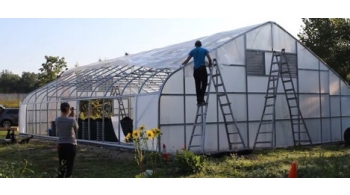
How to install a double-layer inflated plastic
One of the best and easiest solutions for energy-saving of plastic greenhouse is a double-layer inflated plastic. Double-layer inflated plastic works great at providing insulation, proper insulation can make the grower save on fuel costs. Here we are going to explain step-y-step process for those you plan to do it themselves.
Most common needed are: spring wire, a double aluminum channel in the infrastructure, a 6 mm anti-drip greenhouse plastic, a 6mm clear greenhouse plastic, an inflation blower fan, a polyester rope, screws or two-hole straps, and a jumper hose.
Safety. Place some spring wire around the perimeter of the structure within arms’ reach. This is because a grower or installer can immediately take action and secure the plastic if a sudden gust of wind picks up. Then, it’s important also to place ladders, one for both ends of the greenhouse, and one inside the structure, so that additional help can be given if the plastic needs to be better pulled. After all, it’s ready, it’s time to prepare the first roll of greenhouse plastics.
Use a round tube to skewer the roll of greenhouse plastic with the correct side facing down. Double-check the writing on the plastic to see which side is which. Then attach a rope, which needs to be long enough to extend from one end to the other of the structure. Roll the side of the plastic towards the middle where the folds meet. Then, make a little nub, tying the plastic around and folding it back. Make a knot on the top of the poly fold, and one double knot at the bottom of the plastic nub. This is crucial, as it prevents the plastic nub from catching on your bows as you’re trying to pull it across the structure.
Pull the first layer of plastic over the greenhouse. One person grabs the nub, and the other person pulls the rope from the other side of the structure. One person lifts the plastic while the other pulls the rope. This prevents damaging the plastic. At the same time, this needs to go along the center of the structure. If it goes slightly off, go up the ladder you put into the greenhouse previously, and adjust the plastic correctly. When the plastic has reached the other end, remove the knot and flatten the plastic.
If this was just a single-layer cover installation, then the plastic should be as tight as possible. However, since this is going to be inflated, it suffices to be sure that the plastic is well squared on the structure, and that any major wrinkle is pulled out. At this point, apply the spring wire, but without pulling too much. Later that this spring wire will be removed, but only after when the second layer will be secured. You can attach both layers of plastic with one run of spring wires. This saves cost on materials, but it mainly saves a ton of time, since we are not duplicating the process.
To apply the second layer, just repeat what was done for the first layer. It’s crucial to make sure that the folds are even on both sides so that there’s equal weight. Else, the plastic might get off the center of the structure, which would require you to start over.
Once the second layer has been pulled, untie the knot, and open the folds. Pull just enough on both ends to get rid of major wrinkles. Then, start placing the spring wire on the top channel, making sure that the plastic is square and that it is not too tightly secured. Then, it’s time to drop down the sides of the plastic. Do it during a calm day, then it’s quite an easy task. If there’s some wind though, brace yourself for quite an (annoying) challenge. Place the spring wire, and repeat the process for the other side of the greenhouse.
Inflating. When the second layer is on, it’s time to install the blower to inflate the space between the two layers of plastic. Re-visit where you want to install the blower, and unwire the plastic in that space, as you need access between the two layers. So, get up on the ladder again, and pull out some spring wire in the space of choosing. When everything is pinned and ready, it’s time to install the blower fan.
The fan should be 25-30 cm above the hip rail. Attach the mount bracket on the bow, with the orientation based on the pre-drilled holes in the fan. To put in the deflector now, go in between the layers where the hip rail plastic was left detached, and cut through the plastic.
When putting in the jumper hose, which will hang from the ceiling inside the greenhouse, you have to go out and take out a little spring wire, just enough to put your hand underneath the top exterior layer of plastic. Now, grab the jumper hose and remove the end seals. Squeeze the hose underneath both layers of the plastic, a little off the center purling. Slide the other hand in between the layers, and with a razor blade, push it through the most interior layer of plastic, through the hose hole, and use your fingers to widen the hole to fit completely through the first layer of plastic. Grab the end seals back, and put that on the hose, rotate to lock it. Now, do the other half with the same process. Secure the top plastic with spring wire – just one piece for both layers.
Now, the installation of the double-layer inflated plastic is done. To fully inflate the plastic, it might take up to 40 minutes- 2 hours, depending on the size of the greenhouse.
Source: Hortidaily.com
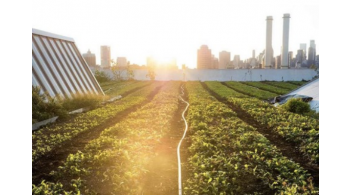
Growing rooftop with CO2 recycled from building ventilation quadruples growth
Researchers have grown a farm of rooftop vegetables bathed in the CO2-rich exhaust air from city buildings— and this idea boosted plant growth by an incredible 400%.
Whats the secret? A building vent! Many people will recognize these silver, mushroom-shaped structures that are visible on urban roofs: they form part of HVAC systems that pump out stale air and ventilate buildings with fresh air from outside. In buildings where lots of people live and work, the CO2 emissions from human respiration can reach surprisingly high levels, which is why these systems are needed to keep the air fresh and unpolluted.
The majority of urban dwellers spend their time indoors—and so cities have a potentially huge and steady supply of CO2 that’s going untapped. These wasted emissions can be used as a resource to create better-growing conditions for plants.
At each of the rooftop vents, the researchers planted neat rows of spinach and corn. Their vegetable patch was laid out in such a way that some plants were beside vents that emitted air from inside the building, while others were planted beside control vents that emitted regular atmospheric air. The plants were also exposed to more or less air power from the vents, to determine the impact of high winds on plants’ ability to use the CO2.
The distinguished growth speed and quality was seen where the exhaust was at most, which is 800-1000 ppm.
Rooftops typically take up 20-30% of urban space, area that goes mostly unused. Looking at the available rooftop area for growing food in the city of Boston where the study was based, the researchers found that if we grew vegetables there and then added CO2 building exhaust to the mix (and assuming also that crops of different varieties would benefit similarly), the city could in fact produce enough food to satisfy 290% of its own vegetable demand.
Read the complete article at www.anthropocenemagazine.org.
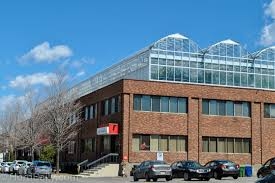
Greenhouses on the rooftops is a trend!
The first greenhouse on the roof of the building was built in Canada in 2009. The Lufa farm at that time realized the dreams of many companies that did not dare to take the first step. Since then, only Lufa has expanded 4 times! Now in its portfolio there are 4 industrial greenhouses for growing fresh vegetable products with a total area of almost 10 hectares.
This trend was picked up by only a few companies in the world, building greenhouses on roofs in France, Germany and the USA. Even though rooftop greenhouses are the obvious best solution for growing vegetables in million-plus cities, this trend is still not as common. And this is an incredible advantage for companies that just want to borrow this idea!
Take note! And our team will be happy to help with advising, design, implementation and building!
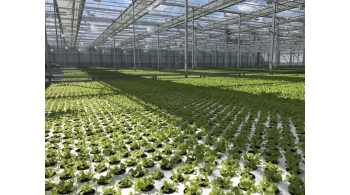
Greenhouse humidity is vital for plant and root health
Complexity of growing
Greenhouse humidity plays a vital role in plant and root health. On certain days, mist system helps to raise our relative humidity by about 25%, which in turn lowers greenhouse temperature by about 4C. This helps to avoid root pressure and keeps transpiration at an optimal level, so the plants don’t shut down and start using their reserve energy.
Mist serves differently in different season. For instance, during the sunny, dry months of May and June, growers can increase the humidity and bring the vents down without increasing the greenhouse temperature. By doing this, they can keep higher CO2 levels in the crop, which increases our rate of photosynthesis.
During the hot summer months, irrigation temperature starts to rise, which can lead to root issues. By keeping the air temperature cooler, this also keeps our leach water temperature cooler and provides more oxygen to the roots system. Healthy roots are an important piece in keeping pathogens like pythium and fusarium away.
Hot and dry conditions are also breeding grounds for pests. Another added benefit to controlling temp and humidity is the mitigation of pests and diseases. Bad bugs thrive in dry conditions, whereas the good bugs start to suffer. By keeping the humidity in control, it keeps our biological program in balance and also limits the spread of pathogens like powdery mildew, thus lowering our overall crop input costs.
Keep your crop safe and yield high, order misting systems at Perspekta!
Source: hortidaily.com